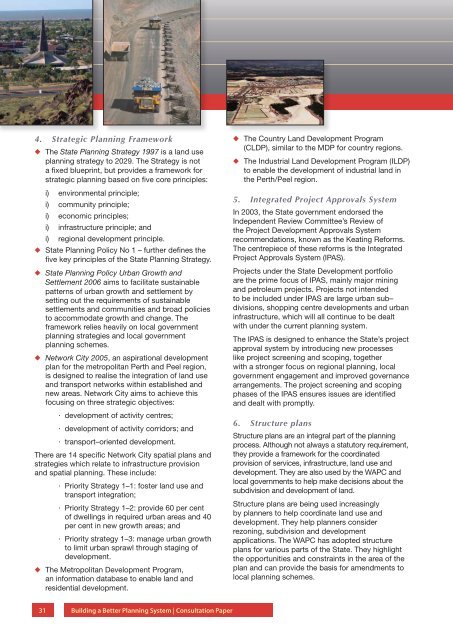Building a Better Planning System - Western Australian Planning ...
Building a Better Planning System - Western Australian Planning ...
Building a Better Planning System - Western Australian Planning ...
Create successful ePaper yourself
Turn your PDF publications into a flip-book with our unique Google optimized e-Paper software.
4. Strategic <strong>Planning</strong> Framework<br />
◆◆<br />
The State <strong>Planning</strong> Strategy 1997 is a land use<br />
planning strategy to 2029. The Strategy is not<br />
a fixed blueprint, but provides a framework for<br />
strategic planning based on five core principles:<br />
i) environmental principle;<br />
i) community principle;<br />
i) economic principles;<br />
i) infrastructure principle; and<br />
i) regional development principle.<br />
◆◆ State <strong>Planning</strong> Policy No 1 – further defines the<br />
five key principles of the State <strong>Planning</strong> Strategy.<br />
◆◆ State <strong>Planning</strong> Policy Urban Growth and<br />
Settlement 2006 aims to facilitate sustainable<br />
patterns of urban growth and settlement by<br />
setting out the requirements of sustainable<br />
settlements and communities and broad policies<br />
to accommodate growth and change. The<br />
framework relies heavily on local government<br />
planning strategies and local government<br />
planning schemes.<br />
◆ ◆ Network City 2005, an aspirational development<br />
plan for the metropolitan Perth and Peel region,<br />
is designed to realise the integration of land use<br />
and transport networks within established and<br />
new areas. Network City aims to achieve this<br />
focusing on three strategic objectives:<br />
•• development of activity centres;<br />
•• development of activity corridors; and<br />
•• transport–oriented development.<br />
There are 14 specific Network City spatial plans and<br />
strategies which relate to infrastructure provision<br />
and spatial planning. These include:<br />
•• Priority Strategy 1–1: foster land use and<br />
transport integration;<br />
•• Priority Strategy 1–2: provide 60 per cent<br />
of dwellings in required urban areas and 40<br />
per cent in new growth areas; and<br />
•• Priority strategy 1–3: manage urban growth<br />
to limit urban sprawl through staging of<br />
development.<br />
◆◆ The Metropolitan Development Program,<br />
an information database to enable land and<br />
residential development.<br />
◆◆ The Country Land Development Program<br />
(CLDP), similar to the MDP for country regions.<br />
◆◆ The Industrial Land Development Program (ILDP)<br />
to enable the development of industrial land in<br />
the Perth/Peel region.<br />
5. Integrated Project Approvals <strong>System</strong><br />
In 2003, the State government endorsed the<br />
Independent Review Committee’s Review of<br />
the Project Development Approvals <strong>System</strong><br />
recommendations, known as the Keating Reforms.<br />
The centrepiece of these reforms is the Integrated<br />
Project Approvals <strong>System</strong> (IPAS).<br />
Projects under the State Development portfolio<br />
are the prime focus of IPAS, mainly major mining<br />
and petroleum projects. Projects not intended<br />
to be included under IPAS are large urban sub–<br />
divisions, shopping centre developments and urban<br />
infrastructure, which will all continue to be dealt<br />
with under the current planning system.<br />
The IPAS is designed to enhance the State’s project<br />
approval system by introducing new processes<br />
like project screening and scoping, together<br />
with a stronger focus on regional planning, local<br />
government engagement and improved governance<br />
arrangements. The project screening and scoping<br />
phases of the IPAS ensures issues are identified<br />
and dealt with promptly.<br />
6. Structure plans<br />
Structure plans are an integral part of the planning<br />
process. Although not always a statutory requirement,<br />
they provide a framework for the coordinated<br />
provision of services, infrastructure, land use and<br />
development. They are also used by the WAPC and<br />
local governments to help make decisions about the<br />
subdivision and development of land.<br />
Structure plans are being used increasingly<br />
by planners to help coordinate land use and<br />
development. They help planners consider<br />
rezoning, subdivision and development<br />
applications. The WAPC has adopted structure<br />
plans for various parts of the State. They highlight<br />
the opportunities and constraints in the area of the<br />
plan and can provide the basis for amendments to<br />
local planning schemes.<br />
31<br />
<strong>Building</strong> a <strong>Better</strong> <strong>Planning</strong> <strong>System</strong> | Consultation Paper

















